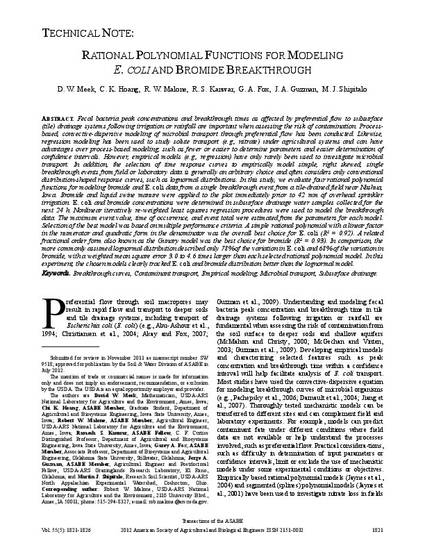
Fecal bacteria peak concentrations and breakthrough times as affected by preferential flow to subsurface (tile) drainage systems following irrigation or rainfall are important when assessing the risk of contamination. Process-based, convective-dispersive modeling of microbial transport through preferential flow has been conducted. Likewise, regression modeling has been used to study solute transport (e.g., nitrate) under agricultural systems and can have advantages over process-based modeling, such as fewer or easier to determine parameters and easier determination of confidence intervals. However, empirical models (e.g., regression) have only rarely been used to investigate microbial transport. In addition, the selection of time response curves to empirically model simple, right skewed, single breakthrough events from field or laboratory data is generally an arbitrary choice and often considers only conventional distribution-shaped response curves, such as lognormal distributions. In this study, we evaluate four rational polynomial functions for modeling bromide and E. coli data from a single breakthrough event from a tile-drained field near Nashua, Iowa. Bromide and liquid swine manure were applied to the plot immediately prior to 42 mm of overhead sprinkler irrigation. E. coli and bromide concentrations were determined in subsurface drainage water samples collected for the next 24 h. Nonlinear iteratively re-weighted least squares regression procedures were used to model the breakthrough data. The maximum event value, time of occurrence, and event total were estimated from the parameters for each model. Selection of the best model was based on multiple performance criteria. A simple rational polynomial with a linear factor in the numerator and quadratic form in the denominator was the overall best choice for E. coli (R² = 0.92). A related fractional order form also known as the Gunary model was the best choice for bromide (R² = 0.93). In comparison, the more commonly assumed lognormal distribution described only 78% of the variation in E. coli and 68% of the variation in bromide, with a weighted mean square error 3.0 to 4.6 times larger than each selected rational polynomial model. In this experiment, the chosen models clearly tracked E. coli and bromide distribution better than the lognormal model.
Available at: http://works.bepress.com/rskanwar/107/

This article was published in Transactions of the ASABE Vol. 55(5): 1821-1826. DOI: 10.13031/2013.42365.